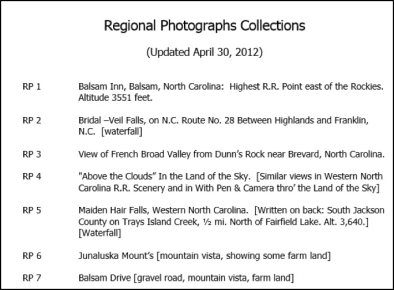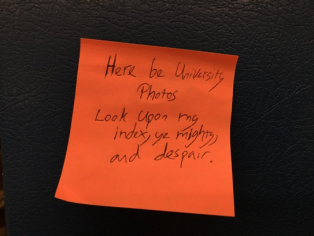By Liz Skene
This blog post is a summary of a lightning talk given at the 2017 SAA annual conference during session 406 – Sympathizing with Sisyphus: Dealing with Inherited or Intransigent Problems in College and University Archives.
Introduction
Western Carolina University (WCU) is located is the heart of the Blue Ridge Mountains, 52 miles west of Asheville and 25 miles east of the Great Smoky Mountains National Park. It is a regional comprehensive university in the UNC system and has just over 10,000 students.

The Special Collections unit at WCU began collecting materials in the mid-1960s and had approximately one filing cabinet worth of materials in 1966. Special Collections got its first official reading room in 1976, had 900 linear feet of materials in 1982, and today has over 3,000 linear feet of materials.
Resources, namely staff, had been slim for much of this time. It wasn’t until 2016 when the Digital Initiatives unit merged with Special Collections and more staff were hired that there was time and manpower to address some long-standing descriptive issues. Concurrent to the merger was an effort to migrate Special Collections finding aids into ArchivesSpace, which would us to make finding aids available online for the first time.

Definitions
So what are the collections? The largest is designated UAs for “university archives.” However, calling them university archives is a misnomer as the university has no archives and the Special Collections unit, although we do have historic records of the university, is not responsible for records across campus. This collection consists solely of photographs of university buildings and events. The second collection is referred to as PDs, or “Printed Documents.” PDs contains ephemera such brochures, maps, and fliers, among other things. There is duplication of this content with a small vertical file but that’s a mystery for another time. Lastly, we have the RPs, our regional photograph and postcard collection.
The Good
The Printed Documents (PDs) collection was the most straightforward to migrate into ArchivesSpace. The inventory for the PDs was a Word document, divided topically with items described individually. In fact, “Printed Documents” was not a unified collection in any sense, but rather has been a catch-all for ephemera, newspapers, and even telephone directories. The contents of the section are described in three separate finding aids: “Printed Documents,” “Newspapers,” and “PD Maps.”
Except from the document outlining the structure of the Printed Documents collections. Image courtesy the author.The first step was to visualize the structure of these collections. We used a Word document to capture the hierarchy to use as a guide for migrating the data into ArchivesSpace. This document also helped us to choose which sections would be a stand-alone Collection/Series set.
Because these disparate collections aren’t linked by a manuscript number, we are using the prefix “Printed Documents” in the title and the prefix “PD” in the inventory numbers. Doing this will allow us to quickly identify and pull together these collections if we feel the need to export or change this descriptive practice.
There are still some issues with display in ArchivesSpace but overall this has been a simple solution for making these collections widely accessible.
The Bad

The Regional Photographs (RPs) inventory was a 171-page Word document with item-level description. The inventory itself was quite useful, however, there were at least three copies of the inventory document. Each said “Updated April 30, 2012” on the first page and each document was titled “Regional Photographs July 2016,” yet the documents were updated in 2014, 2016, and 2017. Which is the authoritative copy is likely a long-gone piece of institutional knowledge.


The Ugly
The 20,000 photographs of the university, known as the UAs or University Archives, was the third Word document inventory. Like the others, there were consistency issues. The document said it listed university photographs to 12,500, although the last entry on the document was 13,923. Furthermore, there were nearly 18,000 photographs on the shelves. The document itself was difficult to use. Initially organized as an index, at some point descriptions switched to item level. Some of this work was done by student workers who had little information about the photographs, resulting in descriptions that were nearly useless.While the UAs are heavily used, navigating and finding what you’re looking for can be daunting. Luckily, our staff has a good sense of humor.


What’s next?
We are steadily making progress on updating, consolidating, and improving access to these three collections. The PDs are being moved into ArchivesSpace, RPs are currently being migrated, and we’re exploring hosting a computer science intern this spring to help with a database for the UAs. We’ll be relying heavily on the controlled vocabularies we developed for our digital collections to structure our descriptive work moving forward and plan to leave documentation of our decisions.
Liz Skene is the Special and Digital Collections Librarian at Western Carolina University. She previously served as a Curator of Collections at the Arab American National Museum in Dearborn, MI. She holds an MSI in Archives & Records Management and Community Informatics from the University of Michigan and BA in English from Spring Arbor University. You can send thoughts, ideas, or commiserations to Liz at emskene@wcu.edu.
